Gorgeous eco-bullies
‘Foreign’ lionfish — aquarium castoffs — have been invading American coastal waters at an alarming rate and gobbling up the natives
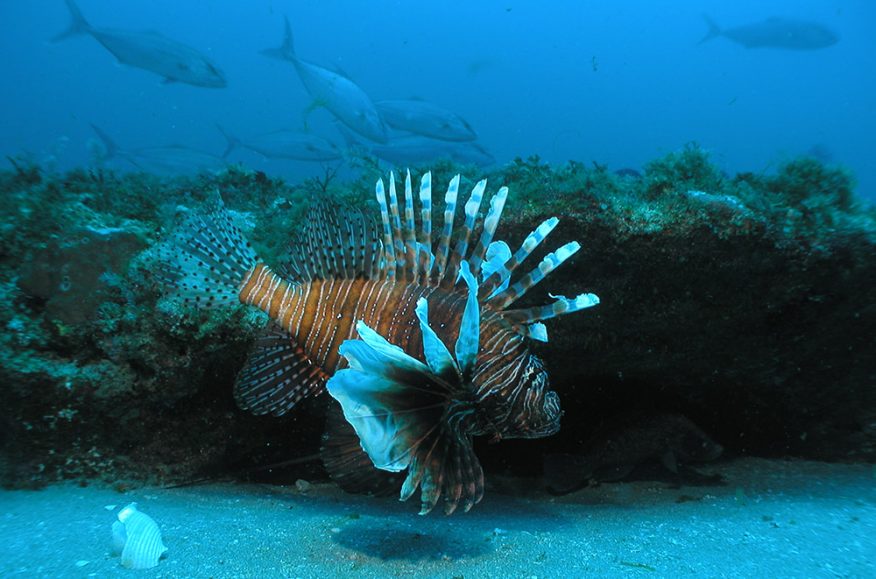
Over the past two decades, lionfish have been overtaking near-coastal waters along the western Atlantic, from North Carolina to as far south as Venezuela. The lionfish pictured here is likely a descendant of released pets.
P. Whitfield
By Janet Raloff
With dramatic red-and-cream stripes and long, broad fans of feathery spines, red lionfish are popular among people with saltwater aquariums. But if released into the wild outside of their native Asia, these beauties can become bad news for the environment. That is certainly proving true in American waters, where the poison-spined fish are spreading rapidly.
A few aquarium specimens got loose a little more than 20 years ago. Since then, the marauders have been multiplying rapidly in Atlantic waters — and eating nearly every fish species in their path.
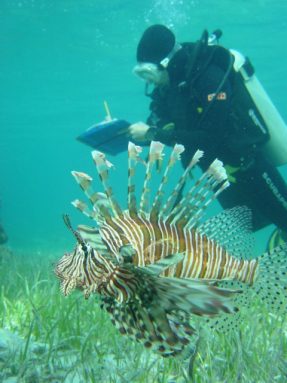
Scientists had briefly held out hope that divers might be able to spearfish the reef-loving invaders and wipe them out. But that dream is over. A new expedition finds that lionfish have expanded their U.S. range beyond the reach of those divers. In addition, the invaders have been rapidly expanding their range.
Red lionfish now regularly prowl U.S. coastal waters from Florida (year-round) north to Massachusetts (in summer). Some recently moved south into the Gulf of Mexico and Caribbean Sea. And pioneering individuals have even begun cruising South American waters.
Their impacts demonstrate the damage that releasing just a few individuals can have on the environment — even a region as vast as the western Atlantic.
Into the deep
Stephanie Green of Oregon State University in Corvallis is a lionfish expert. This summer, she was part of a team that explored deep patches of the Florida coast. Until now, she says, two species of invasive lionfish appeared to live only in relatively shallow waters — depths of about 15 meters (50 feet) or less. A few isolated camera sightings from tiny, unmanned research subs showed lionfish could travel deeper, even to 300 meters (about 1,000 feet). But biologists had assumed that this was the occasional fish venturing beyond its comfort zone.
Now Green and her coworkers have established that the invaders are thriving at substantial depths.
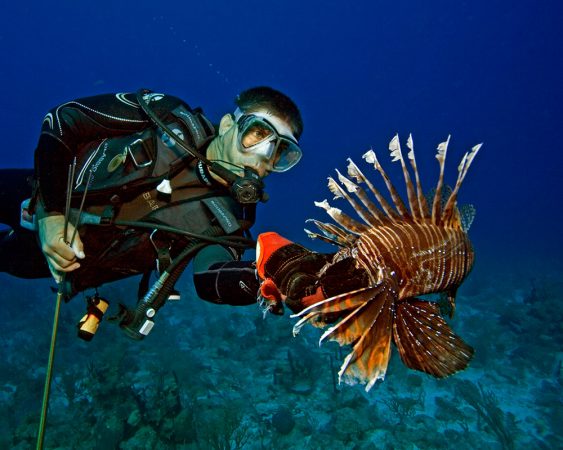
These fish were dwelling in a part of the ocean referred to as the twilight zone. Here, some sunlight penetrates — but not much. “It’s an area where there is still lots of fish life and lots of coral. But it’s beyond diving depths,” Green explains. “So we really don’t do much science in that zone.”
Before her group’s deep-water survey, “I had feared that we would find lionfish,” Green says. “And we have now definitely confirmed that.” All were adults, about 20 to 25 centimeters (about 8 to 10 inches) long. And they weren’t living only on coral reefs. Says Green, “They appear to live on all different habitats down at that depth.”
Other scientists report similar discoveries elsewhere along the U.S. Atlantic coast. “Lionfish have been reported in deep water off of North Carolina — 300 feet or so — almost since the beginning of its invasion,” says Paula Whitfield. She’s a research ecologist with the National Oceanic and Atmospheric Administration in Beaufort, N.C. The waters off the Carolinas mark the northern edge of the species’ year-round American range. There, says Whitfield, “we’ve found that lionfish numbers are usually higher in deeper areas” than in shallower waters.
This suggests, she says, that the species may have invaded the deeper areas first. Later, they may have expanded into the shallower sites, where they finally attracted attention.
Lionfish bully the natives
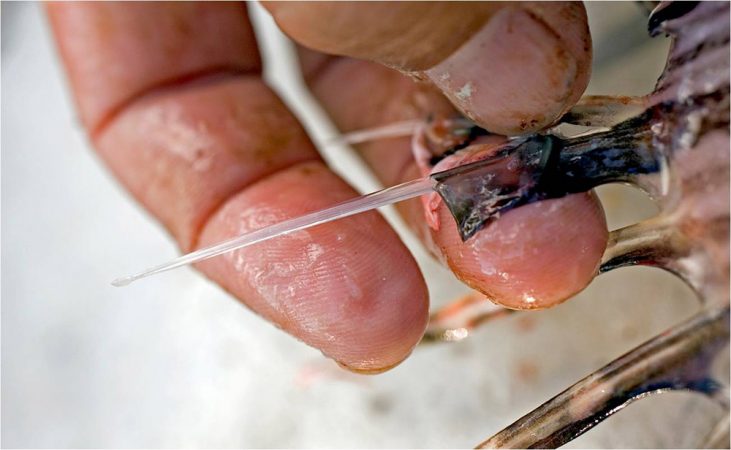
Akins works for the Reef Environmental Education Foundation, in Key Largo, Fla. The group is devoted to helping protect the ocean “by educating, enlisting and enabling divers and other marine enthusiasts to become active ocean stewards and citizen scientists.” Recently, the group identified lionfish as a big threat to ocean life in the western Atlantic.
“Imagine how a lion would hunt on an African savanna,” Akins says. The big cat begins a hunt when it glimpses nearby prey and starts to stalk it. As it tracks that prey, it begins closing the distance between itself and its victim. When it’s close enough, the cat makes one last rush to bring its dinner down. “And that’s kind of what a lionfish does,” Akins says. It stalks its prey until it’s less than a foot away. Then it makes a rapid rush, opens its mouth — “and down the prey goes.” In one gulp.
Indeed, “lionfish are ambush predators,” notes Nicholas Higgs at Plymouth University’s Marine Institute in England. In order to study lionfish impacts in the Bahamas, he caught specimens that had been hiding out in “condos” there. These artificial boxes are deployed by fishermen hoping to catch lobsters. By studying the contents of lionfish stomachs, Higgs determined what they were eating. He found that in this Caribbean habitat, 77 percent of the lionfish meals consisted of fish. Shrimp made up most of the rest. Lionfish also ate a few small crabs.
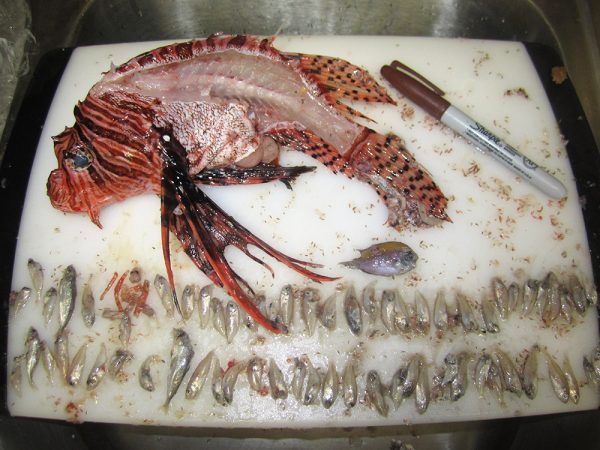
Especially troubling for the environment, lionfish dine on “cleaner” fish. For instance, Akins notes, lionfish eat species like the Spanish hogfish and bluehead wrasse. These grooming fish help protect the health of important predatory species, like groupers and barracudas. How? By picking parasites off of them. Lionfish also gobble up parrotfish and other species that graze on algae. “And, of course, if the grazers are not able to keep it in check, algae can overgrow and kill the corals,” Akins explains. “That could impact the entire ecosystem.”
In fact, he argues, “That’s the scary part of the lionfish invasion.” These fish eat such a wide variety of prey that they threaten most ocean species. And sporting a wide fan of poison-releasing spines on each side of their bodies, lionfish have little to fear from predatory carnivores.
For instance, Mark Albins and Mark Hixon of Oregon State University have observed that “even when sharks or large grouper do attack, they almost always immediately retreat without obvious injury to the lionfish.” It seems that big meat-eating fish quickly learn to look elsewhere for lunch.
Akins points to another “scary” aspect of lionfish: their ability not only to eat a lot, but also to survive enormously long periods, if needed, between meals.
Lev Fishelson of Tel Aviv University in Israel has spent decades studying the lionfish native to the nearby Red Sea. From watching them eat, he and his coworkers found that adults ate about 8.5 grams (a third of an ounce) of fish per day. Since each meal consists of small fish, Fishelson estimates that the average adult lionfish “will consume over 50,000 fish per year.”
But the big surprise was how long lionfish could get by when their food supply vanished.
To examine this, Fishelson raised two species of lionfish in the lab. One was Pterois volitans, the species most widely invading American waters. He monitored the fishes’ food intake from when they were juveniles through adulthood. In one experiment, he then took away all of their food and monitored the fishes’ health.
The lionfish didn’t waste away. In fact, they didn’t even shed much weight, despite being on this starvation diet. Throughout three months without food, P. volitans lost only 5 to 16 percent of its weight. On a percent basis, the youngest and smallest fish experienced the biggest weight losses: about one-third of their starting weight. By comparison, full-size adults dropped only around 10 percent of their starting weight.
“Anyone with a home aquarium knows that if you don’t feed your fish, in a couple of days they’ll be belly up,” Akins says — quite dead. Yet none of Fishelson’s lionfish died. They just patiently waited month after month for the next meal.

Making changes
One reason for the rapid spread of lionfish may be their lightning-fast growth. It’s something that Albins recently witnessed during a set of 8-week tests he conducted at a research site in the Bahamas.
Many years ago, researchers moved 32 small patches of reef corals to a fairly remote spot. This became a research site. Albins visited the corals here and recorded what fish had taken up residence. Then, at 20 sites he removed all adult fish-eating species, including lionfish. Afterward, he introduced a single adult grouper or lionfish to half of those sites. At the rest he introduced one of both types — or none. Then he recorded what happened to these transplanted fish.
The lionfish grew six times as fast as the groupers in both weight and length. That lionfish growth is twice what’s seen among lionfish in their native, or home, range.
Lots of different types of small fish moved into test sites where no predators had been added. Fewer new species moved into reef sites where the lionfish or groupers were now living. And among these sites, reefs with lionfish recruited only half as many new species as the sites with groupers. Albins reported his new findings January 2013 in the journal Biological Invasions.
Concludes Albins: Under the same conditions in the wild, lionfish grew much faster than a native predatory reef fish, the grouper. The lionfish also “had stronger effects on native coral-reef fish communities,” cutting both the number of individuals and number of species present.
Exploding range
Divers first sighted lionfish in the Atlantic in the late 1980s, Green notes. No one knows for certain where they came from. The leading suspicion: One or more pet owners released their fish into the ocean as a humane way to get rid of them.
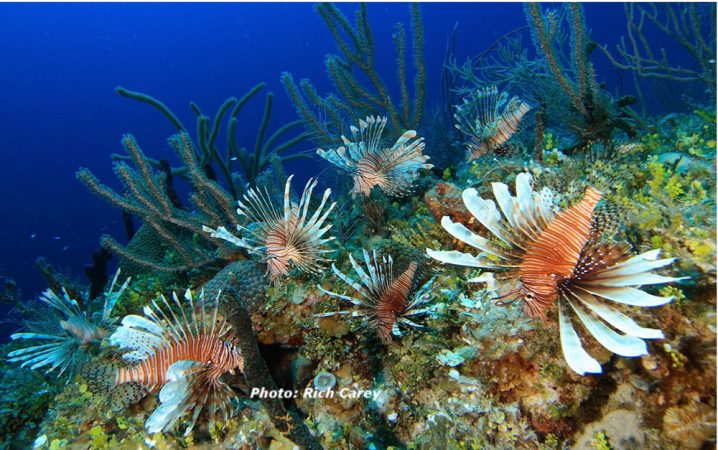
The broader-ranging P. volitans appeared to all be descendants of fish native to western Indonesia, the scientists reported in the Journal of Biogeography. But the genetics of all members of this species in the Atlantic show far less variation than do these fish in the Pacific. The best explanation, the biologists conclude, is that these fish in American waters all result from the release of between eight and 12 fish, probably around Florida.
However those first lionfish might have entered the Atlantic, they clearly found their new digs comfortable. There was ample food, plenty of space and few dangers. So the fish settled in and reproduced. Again and again and again.
In fact, their invasion “is pretty unprecedented,” notes Whitfield. No other ocean fish has spread so widely and so quickly, she explains. And that spread conforms to a general cycle, she notes. Where the species first appears, people encounter a lone fish. The next year, scientists hear of two individual sightings in that same general region. A year later, divers will tend to see a few small groups of lionfish. In the fourth year, lionfish numbers explode, she says: “They appear to be everywhere” at the new site.
“We saw this first off North Carolina,” she says. “Now, in the Caribbean, a lot of places are beginning to embark on their fourth year of this cycle.” And in the Gulf of Mexico, she says, “they’re approaching year three on that trajectory.” The lionfish “are not well established, but they appear on their way to becoming established.”
Most recently, some have been seen swimming off of Central America, Colombia and Venezuela. This trajectory should take them on to Brazil.
This just goes to show how big an impact the release of a few fish can be, notes Akins. “We all love our pets. And we want to do what we think is best for the animals. But in a case like this, releasing them is certainly not what’s best for the environment. And in the case of the other animals that do belong in that environment, they are now paying the price.” It’s possible that some eventually could face extinction, he says.
Power Words
Atlantic One of the world’s five oceans, it is second in size only to the Pacific. It separates Europe and Africa to the east from North and South America to the west.
biologist Biology is the study of living things. The scientists who study them are known as biologists.
carnivore An animal that either exclusively or primarily eats other animals.
ecology A branch of biology that deals with the relations of organisms to one another and to their physical surroundings. A scientist who works in this field is called an ecologist.
ecosystem A group of interacting living organisms — including microorganisms, plants and animals — and their physical environment within a particular climate. Examples include tropical reefs, rainforests, alpine meadows and polar tundra.
extinction The state or process of a species, family or larger group of organisms ceasing to exist.
genetic Having to do with chromosomes, DNA and the genes contained within DNA. The field of science dealing with these biological instructions is known as genetics.
groupers Large warm-water sea basses. These predatory fish, a popular sport and food fish (especially the red, black and gag groupers), themselves target many smaller species.
habitat The area or natural environment in which an animal or plant normally lives, such as a desert, coral reef or freshwater lake. A habitat can be home to many different organisms.
invasive species (also known as aliens) A species that is found living, and often thriving, in an ecosystem other than the one in which it evolved. Some invasive species were deliberately introduced to an environment, such as a prized flower, tree or shrub. Some entered an environment unintentionally, such as a fungus whose spores traveled between continents on the winds. Still others may have escaped from a controlled environment, such as an aquarium or a laboratory, and begun growing in the wild. What all of these invasives have in common is that their populations are becoming established in a new environment, often in the absence of natural factors that would control their spread. Invasive species can be plants, animals or disease-causing pathogens. Many have the potential to cause harm to wildlife, to people or to a region’s economy.
marine Having to do with the ocean world or environment.
parasite A creature that gets a benefit from another organism, called a host, but doesn’t provide it any benefits. Classic examples of parasites include ticks, fleas and tapeworms.
predator (adjective: predatory) A creature that preys on other animals for most or all of its food.
prey Animal species eaten by others.
range The full extent or distribution of something. For instance, a plant or animal’s range is the area over which it naturally exists.
reef A ridge of rock, coral or sand. It rises up from the seafloor and may come to just above or just under the water’s surface.
savanna A grassland sometimes also populated with trees. Most are fairly dry for part or much of the year.
snappers More than 100 species of large and predatory schooling fish, often found near the tropics. Many are prized as a food fish (especially red snapper).
species A group of similar organisms capable of interbreeding.
trajectory The path taken by a projectile moving through space and time, or the direction that a trend is taking over time.







